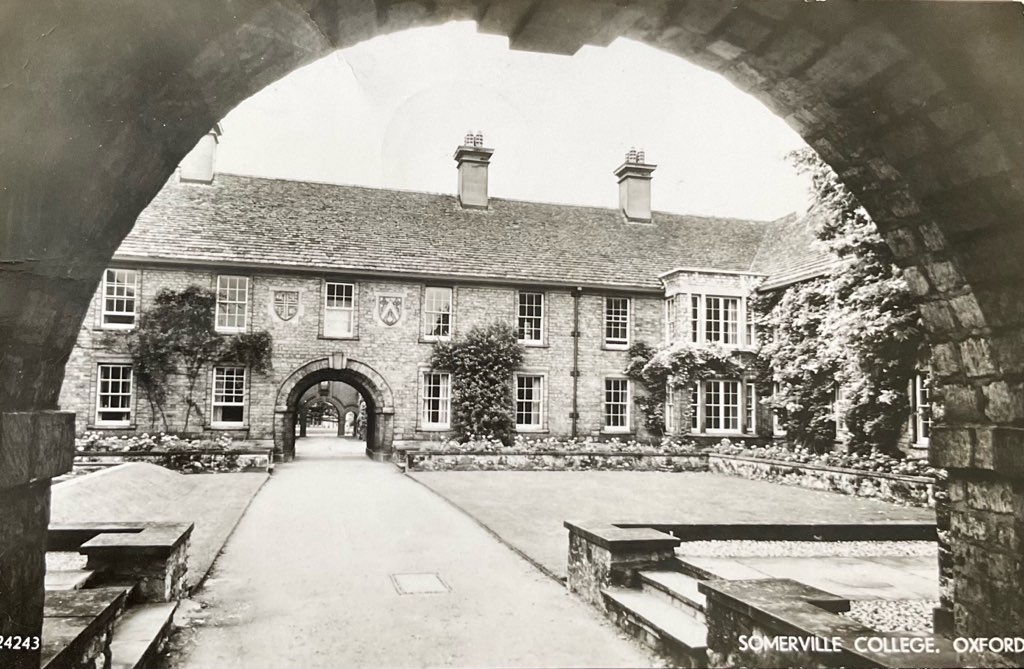Ah, Oxford – city of dreaming spires and, historically, sexism.
Today’s card shows Somerville College, which played a significant part in challenging that, and advancing higher education for women.
In 1878 moves were afoot in Oxford to create a ladies’ hall – that is, a place where women could live and study and gain an Oxford education (but note not, at that time, a degree). Bedford College in London was by now enabling women to take University of London degrees, and Oxford had some catching up to do.
But Oxford being Oxford, the people agitating for a ladies’ hall argued about religion, and split into two factions. One faction – the Christ Church camp – argued that the hall must require students to profess the Anglican faith, and this group went on to found Lady Margaret Hall (of which more another day). The other group – the Balliol camp – founded a non-denominational hall, which was named after Mary Somerville, pioneering Scottish mathematician and writer, who had died in 1872.
Twelve students enrolled as Somerville Hall’s first cohort. Which was all well and good, but they were unable to attend university lectures or, as noted, take degrees. But this changed over the coming years – first chemistry lectures were opened up, in 1880, and other subjects followed a couple of years later. Somerville had begun to expand physically too, purchasing a house from St John’s College.
In 1884 the university opened up examinations to women (note that this meant they could sit the examinations, and have their work marked, but it did not yet mean the award of degrees). The college’s history notes how Somerville’s students celebrated this step, with a nocturnal party, dancing, and singing: “in spite of all temptations – to avoid examinations – we will do them if we can.”
The college continued to grow, with more students, a research fellowship, and the establishment of the college library. A notable first occurred in 1889 – Somerville admitted the first Indian women to enrol at a UK university. This was Cornelia Sorabji, also the first woman to graduate from Mumbai University, and the first woman to be admitted as a reader at the All Souls library in Oxford.
In 1894 Somerville changed its name to Somerville College, and in 1896 the college sought to enable its students to be awarded degrees. This was unsuccessful, but the college did award BA diplomas to its students who had passed the examinations for the university degree. Women were not permitted at this time to use the Bodleian library, so the completion of the college library in 1903 was a significant milestone. It remains one of the largest undergraduate libraries in the university.
In 1908 Somerville required applicants to pass an entrance exam. Its journey to adopting the norms of Oxford life was continuing. And in 1920 a huge step occurred – women were to be permitted to take degrees of the university. The decision included the power to award degrees to past students, so 300 Somerville alumna who had passed the university’s examinations were awarded degrees. And the first Oxford degree awarded to a woman was to Somerville’s principal, Emily Penrose.
Somerville continued to thrive, attracting some notable students (for example, the philosophers Iris Murdoch, Phillippa Foot, and Mary Midgley). And in 1959 the University finally granted the women’s colleges full collegiate status. Fun quiz – without googling, how many of the colleges founded to admit women can you name?
Somerville also educated politicians. Indira Gandhi, the first woman to be Prime Minister of India, was an alumna; as was Margaret Thatcher, the first woman to be Prime Minister of the UK. And when on the subject of politicians, it would be remiss not to mention Shirley Williams, Somerville alumna, sometime secretary of state for education, and co-founder in 1981 of the Social Democratic Party.
One more notable name: Dorothy Hodgkin, Somerville alumna and later research fellow at the College. Hodgkin was a Nobel prize-winning chemist, awarded for her work in mapping the structure of vitamin B12. She was Margaret Thatcher’s tutor when she studied at Somerville, and Thatcher had a portrait of Hodgkin in her office at Downing Street. Hodgkin, however, was a lifelong Labour voter.
In 1992 Somerville took a decisive step: the governing body deciding to admit men as students. The decision was challenged by the Junior Common Room, the voice of the college’s undergraduate students, which appealed to the college’s Visitor (the role of Visitor has largely been rendered otiose by the creation of the Office of the Independent Adjudicator. It was an impartial overseer, acting on behalf of the monarch, who had awarded a charter). The visitor was Roy Jenkins, former home secretary, and coincidentally another co-founder of the SDP. He did not overturn the decision, but delayed its implementation until 1994, when the first men were admitted as students.
Our account is almost complete. But one image remains: that of the Somerville quad.

This is not from the #HigherEducationPostcard collection, but from Pamela Marsden, a Somerville alumna and student in the 1960s. While at the college she sent the card to an aunt, and the card is now back once more in her possession. A jolly fine card it is too, and I am grateful to Pamela for allowing me to share it here.












